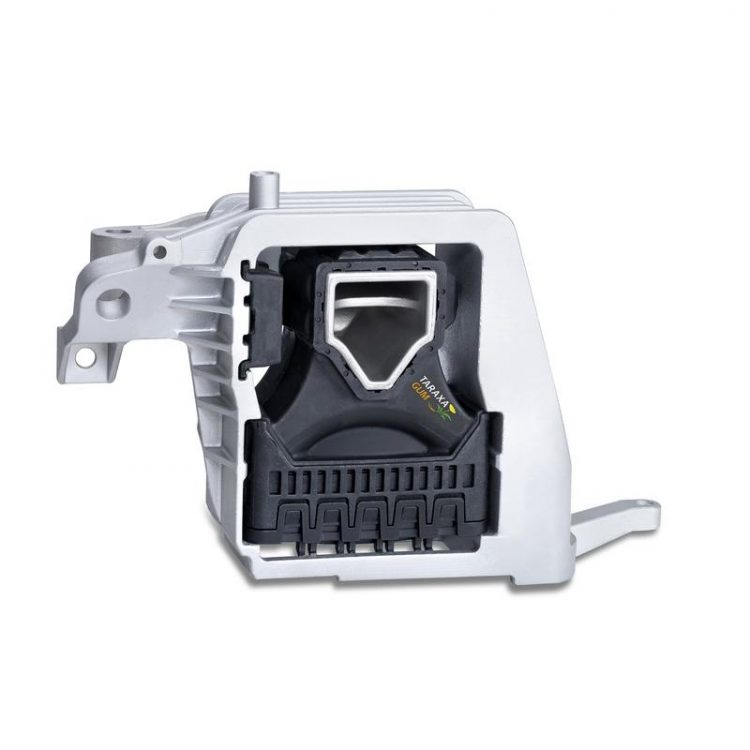Engine mounts made from dandelions

ContiTech engine mount Taraxagum ContiTech
ContiTech Vibration Control developers are now testing if natural rubber made from dandelions might also be used to reduce engine vibrations. At the IAA ContiTech presents first and promising research findings for a possible application in mounting elements in vehicles. The natural rubber is supposed to adapt the elements to different applications in gearbox and enginge mounts and at the same time make the parts durable.
They bear static loads, insulate the structure-borne sound, limit the movement of the engine, and prevent it from tearing off in the event of an accident. They also damp vibrations and impacts that come from the roads.
»The demands on engine mounts are completely different to those on tires. For example, we have to cope with heavy dynamic loads at high temperatures. This means that the focus of our developments is different to that of our tire colleagues,« says Dr. Anna Misiun, who leads the research activities of the project at ContiTech. Regardless of the different products for which dandelion rubber might be used, it always implies considerable environmental benefits.
Better CO2 balance of the raw material,
greater independence from market fluctuations
Professor Dirk Prüfer and Dr. Christian Schulze Gronover of the Fraunhofer IME and the IBBP: »The plant is extremely resilient, able to grow in moderate climates and even in soil that is not suited for the cultivation of food and feed crops. Thus, there is no need for transportation from tropical countries. This improves the CO2 balance of the raw material considerably.« Moreover, the greater independence from traditional raw materials with sometimes highly fluctuating market prices also offers advantages for the industry.
The development of an environmentally and resource friendly production process for natural rubber on an industrial scale is the overarching objective of the collaboration of the scientists from Continental and Fraunhofer IME. This objective has already come a lot closer with the development of a laboratory-scale pilot plant for the extraction of natural rubber from the roots of the Russian dandelion – and with the production of corresponding tire prototypes.
In tests under summer and winter conditions, those tires performed just as well as tires made with rubber tree caoutchouc. For their achievements, the scientists involved were awarded with a Joseph-von-Fraunhofer Prize 2015th. Now, the production is to be scaled up so that it finally works for industrial use, measured in tons. With that, in rubber production, the «blowball« develops to an ecologically and economically very attractive alternative to the tropical rubber tree.
However, it will still take several years until industrial production can start. »First, the homework has to be done: The plant needs to be further optimized. For the highest possible rubber yield, for sowing, planting and rubber extraction on a large scale,« say the two scientists.
Media Contact
All latest news from the category: Materials Sciences
Materials management deals with the research, development, manufacturing and processing of raw and industrial materials. Key aspects here are biological and medical issues, which play an increasingly important role in this field.
innovations-report offers in-depth articles related to the development and application of materials and the structure and properties of new materials.
Newest articles

High-energy-density aqueous battery based on halogen multi-electron transfer
Traditional non-aqueous lithium-ion batteries have a high energy density, but their safety is compromised due to the flammable organic electrolytes they utilize. Aqueous batteries use water as the solvent for…

First-ever combined heart pump and pig kidney transplant
…gives new hope to patient with terminal illness. Surgeons at NYU Langone Health performed the first-ever combined mechanical heart pump and gene-edited pig kidney transplant surgery in a 54-year-old woman…

Biophysics: Testing how well biomarkers work
LMU researchers have developed a method to determine how reliably target proteins can be labeled using super-resolution fluorescence microscopy. Modern microscopy techniques make it possible to examine the inner workings…





















